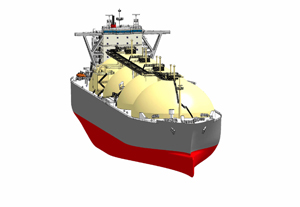First Order Received for the Newly Developed 182,000 m³ LNG Carrier
Jun. 04, 2013

Tokyo, June 4, 2013 — Kawasaki Heavy Industries, Ltd. announced today that it has signed a shipbuilding contract with Kawasaki Kisen Kaisha, Ltd. for one 182,000 m3-type LNG carrier. The vessel is to be built at Kawasaki's Sakaide Shipyard and is slated for completion in October 2016. Once completed, the vessel is scheduled to be used to transport LNG that the CPC Corporation, Taiwan will purchase from the Ichthys LNG Project in Australia, which is led by INPEX CORPORATION.
The latest order is for a newly developed MOSS-type LNG carrier boasting the world's largest cargo tank capacity of 182,000 m3. This vessel was developed based on the 177,000 m3-type LNG carrier, previously the largest MOSS-type LNG carrier on offer from Kawasaki. The approximately 5,000 m3 increase in cargo tank capacity was achieved by making the most of the design features of the 177,000 m3 Pacific Max and equipping the vessel with two stretched spherical Moss-type tanks and two spherical Moss-type tanks. Stretched spherical tanks have a cylindrical section (equator) approximately 1.6 m in length added to the conventional spherical tank to increase cargo tank capacity. The new vessel will be the first Moss-type LNG carrier to come equipped with a DFD electric propulsion system* to offer excellent fuel efficiency across a broad range of speeds.
LNG Carriers are generally fueled by natural gas that evaporates during transport (boil-off gas). While recent technological advances have reduced the amount of fuel consumption, they gave rise to a new problem of excess boil-off gas that is left behind without being consumed as fuel. Kawasaki's LNG Carriers feature a proprietary thermal insulation system — Kawasaki Panel System — with an excellent track record spanning over 30 years. The panel system has been further improved for the new ship to achieve the world's lowest boil-off rate at 0.08% per day. With this improvement, the ship is able to minimize unused boil-off gas for outstanding environmental performance and economic efficiency.
| The ship's principal particulars are outlined below. | |
|---|---|
| Length: | Approx. 300 m |
| Molded breadth: | 52.0 m |
| Tank capacity: | 182,000 m3 |
| Speed: | 19.5 knot |
| Boil-off rate: | 0.08% per day |
Kawasaki will actively pursue its shipbuilding operations in light of the expected rise in demand for LNG and other clean energy fuels.
The DFD (Dual Fuel Diesel) engine is capable of burning both oil and gas while a conventional generator engine can only burn oil for fuel. The propulsion system is comprised of a number of generator diesel engines, variable speed propulsion motors and other components. Either gas or oil is supplied to the engines to generate electricity, which drives the propulsion motors that power the propeller.
Contact
If you need more information about our business,
please feel free to contact us.





